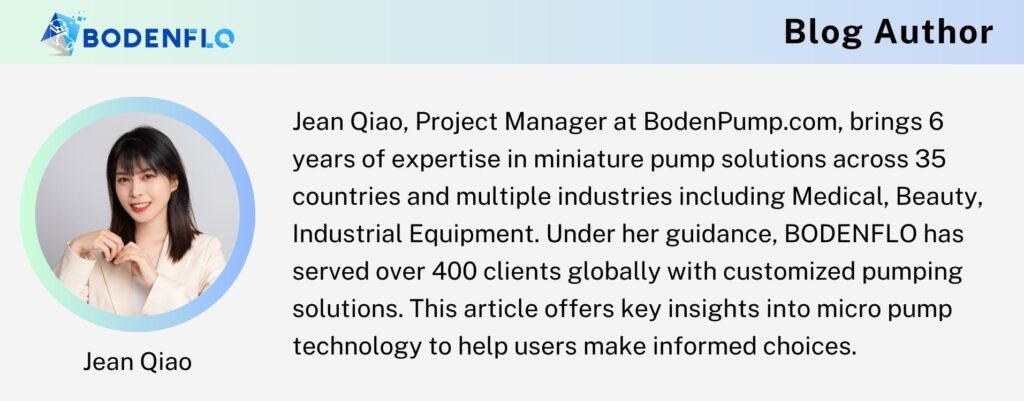
The distinction between micro air pumps and micro vacuum pumps is not just academic; it holds practical implications for various industrial applications. Knowing these differences is imperative for procurement professionals, engineers, and distributors who are in the market for these types of pumps.
Answer: Micro air pumps are designed primarily for pushing air, whereas micro vacuum pumps are engineered to create a vacuum to pull air or fluids. This fundamental difference dictates their respective applications and operational constraints.
After highlighting the crux of the differences between micro air pumps and micro vacuum pumps, this article will further elaborate on these distinctions in the following sections:
- The Fundamental Differences: Delve into the basic differences in purpose, pressure range, common uses, and materials used.
- Operational Principles: Understand the mechanics that make each type of pump work.
- Applications Across Industries: Explore where these pumps are most commonly used.
- Quality Control and Specifications: Examine the industry standards and quality measures that these pumps should meet.
By providing a detailed analysis of each of these aspects, the article aims to equip procurement professionals, distributors, and end-users with the knowledge required for informed decision-making in the realm of miniature pumps.
The Fundamental Differences: Distinguishing Micro Air Pumps from Micro Vacuum Pumps
The confusion between micro air pumps and micro vacuum pumps often stems from their overlapping functionalities and design elements. However, their distinctions lie mainly in their operational principles, design features, pressure capacities, and end-use applications.
Operational Principles
- Micro Air Pumps: Primarily designed to move air or gas from one place to another, these pumps usually work on the principle of positive displacement.
- Micro Vacuum Pumps: Engineered to create a vacuum to draw air or gas into them, these pumps often utilize negative displacement mechanics.
Design Features
- Micro Air Pumps: Generally incorporate features for continuous flow and may not have strong suction capabilities.
- Micro Vacuum Pumps: These are typically built for strong suction and may not be ideal for tasks requiring continuous flow.
Pressure Capacities
- Micro Air Pumps: Generally optimized for lower pressure ranges and high flow rates.
- Micro Vacuum Pumps: Engineered for high pressure and low flow rates, focusing on creating a powerful vacuum.
End-Use Applications
- Micro Air Pumps: Commonly found in systems like aquariums, pneumatic seats, and air mattresses.
- Micro Vacuum Pumps: More likely to be used in applications like medical equipment, HVAC systems, and laboratory setups requiring a vacuum.
Materials
- Micro Air Pumps: Often made of lighter materials suitable for less harsh conditions.
- Micro Vacuum Pumps: Usually constructed with more durable and robust materials that can withstand higher pressures and potentially corrosive materials.
Operational Principles: Unpacking the Mechanics of Micro Air Pumps and Micro Vacuum Pumps
Understanding the operational principles of micro air pumps and micro vacuum pumps is crucial for those involved in procurement and distribution. These principles dictate not only the pump's performance but also its suitability for specific applications.
Micro Air Pumps: Positive Displacement Mechanism
Micro air pumps usually operate on a positive displacement mechanism. In simple terms, they work by trapping a fixed volume of air and displacing it from the intake side to the discharge side. This method is particularly efficient for tasks requiring continuous flow of air or gas at a relatively lower pressure. Different types of actuators, such as diaphragm, piston, or gear, can be used to achieve this positive displacement.
Micro Vacuum Pumps: Negative Displacement Mechanism
On the other hand, micro vacuum pumps often operate on negative displacement principles. These pumps are engineered to generate a vacuum, which is a space devoid of matter. By creating a vacuum, they draw air or gas into the system. This makes them optimal for high-pressure, low-flow rate scenarios where strong suction is required. Depending on the application, various actuators like rotary vane, diaphragm, or scroll can be deployed.
Comparison of Actuator Types
While both types of pumps can use similar actuators like diaphragms or pistons, the key difference lies in how these actuators are utilized. In micro air pumps, the focus is on achieving a continuous flow, whereas in micro vacuum pumps, the priority is to create a powerful suction force.
Impact on Performance Metrics
These operational principles directly affect the pump’s performance metrics such as flow rate, efficiency, and maximum attainable pressure or vacuum, thus making them a cornerstone in selecting the right pump for your specific needs.
Applications Across Industries: Where Micro Air Pumps and Micro Vacuum Pumps Shine
Micro air pumps and micro vacuum pumps are utilized across a multitude of industries, each type having unique benefits that make them particularly suited for specific applications. Below are some of the industries where these pumps play a critical role.
Medical Industry
Micro Air Pumps
In medical settings, micro air pumps are often used in devices like oxygen concentrators and nebulizers. The precise and reliable flow of air is essential in these life-critical applications.
Micro Vacuum Pumps
Dialysis machines and medical suction equipment are typical applications where micro vacuum pumps are indispensable. They provide the required suction power while maintaining high levels of sterility.
Laboratory Applications
Micro Air Pumps
In laboratories, micro air pumps are used in automated chemical analyzers and air samplers. Their capability to provide a consistent air flow is vital for accurate results.
Micro Vacuum Pumps
Here, these pumps are commonly seen in filtration systems and fume hoods where a vacuum is needed to remove hazardous particles or gases.
Environmental Monitoring
Micro Air Pumps
These pumps are crucial in air quality monitoring equipment, allowing for the consistent collection of air samples for analysis.
Micro Vacuum Pumps
In water quality testing, micro vacuum pumps can draw water samples into testing chambers in a controlled manner.
Automotive Industry
Micro Air Pumps
These pumps find their application in tire inflation systems and in some advanced cooling mechanisms.
Micro Vacuum Pumps
In automotive applications, these pumps are used in brake boosters and fuel vapor recovery systems.
Consumer Electronics
Micro Air Pumps
Air pumps in this sector are commonly found in small aquariums or in cooling systems for advanced electronics.
Micro Vacuum Pumps
Used in robotic cleaning devices, these pumps help create the suction needed to pick up small particles from surfaces.
Industrial Applications
Micro Air Pumps
In industrial applications, micro air pumps serve crucial roles in pneumatic systems, conveying systems, and cooling systems. Their compact size and high efficiency make them ideal for precise air pressure regulation, which is vital for the optimal performance of industrial machinery.
Micro Vacuum Pumps
These pumps find applications in robotics, specifically for suction grip functionalities. They are also integral to HVAC systems for maintaining precise pressure levels, and in industrial vacuum cleaners where high suction capability is a requirement.
Food and Beverage Industry
Micro Air Pumps
In the food and beverage sector, micro air pumps are commonly used in carbonation processes for drinks and in the aeration of certain types of food products. They guarantee the uniformity and quality of the end products.
Micro Vacuum Pumps
These pumps play a vital role in vacuum packing food items, preserving their freshness and extending shelf life. They are also used in the wine industry for degassing and filtration processes.
Quality Control and Specifications: Ensuring Reliability and Compliance
In the realm of micro pumps, quality control and adherence to specifications are non-negotiable, especially for those in procurement and distribution. Knowing the standards and specifications to which these pumps are manufactured can be the difference between a successful project and a costly failure.
ISO Certifications
The majority of reputable manufacturers are compliant with ISO 9001 or similar quality standards. These standards ensure a level of quality and reliability that is expected in industrial applications.
In-House Testing
High-quality pumps are subjected to rigorous in-house testing procedures. Parameters like high-pressure performance, vacuum levels, and flow rates are verified through calibrated instruments. This is especially crucial for applications demanding high levels of precision, such as in medical or laboratory settings.
Material Specifications
The materials used for the pump components, like diaphragms and valves, should meet industrial-grade specifications. Often these materials need to be resistant to chemicals, high temperatures, and wear and tear.
Operational Tolerances
Understanding the operational tolerances of a pump, such as its maximum pressure, vacuum, and temperature conditions, is vital for safe and efficient operation.
Documentation
Finally, all these specifications should be well-documented, easily accessible, and verifiable. Most manufacturers provide comprehensive datasheets that include all necessary information for the buyer.
Conclusion: The Importance of Informed Decision-Making
Understanding the nuances between micro air pumps and micro vacuum pumps is crucial for procurement officers and distributors in making informed decisions. From operational principles to industry-specific applications and quality control standards, each detail counts. As specialists in the field, BODENFLO offers a range of parametrically customizable micro pumps designed to meet high pressure, vacuum, and flow requirements across industries. Our commitment to quality assurance aligns with international standards, making us a reliable partner in your supply chain.
For premium quality micro pumps tailored to your needs, contact BODENFLO(info@bodenpump.com) today.


